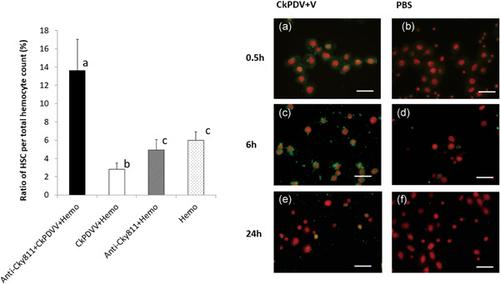当前位置:
X-MOL 学术
›
Arch. Insect Biochem. Physiol.
›
论文详情
Our official English website, www.x-mol.net, welcomes your
feedback! (Note: you will need to create a separate account there.)
Cky811 protein expressed by polydnavirus and venom gland of Cotesia kariyai regulates the host Mythimna separata larvae immune response function of C-type lectin responsible for foreign substance recognition which suppresses its melanization and encapsulation
Archives of Insect Biochemistry and Physiology ( IF 1.5 ) Pub Date : 2021-04-05 , DOI: 10.1002/arch.21786 Tomomi Sawa 1 , Toshiharu Tanaka 2 , Yoshiaki Kato 3 , Yutaka Nakamatsu 1
Archives of Insect Biochemistry and Physiology ( IF 1.5 ) Pub Date : 2021-04-05 , DOI: 10.1002/arch.21786 Tomomi Sawa 1 , Toshiharu Tanaka 2 , Yoshiaki Kato 3 , Yutaka Nakamatsu 1
Affiliation

|
Cotesia kariyai (Ck) larvae implanted into the body cavity of the Mythimna separata (armyworm) larvae get melanized and encapsulated after adhesion by hemocytes called hyperspread cells (HSCs). The present study showed that HSCs could not adhere to the implanted Ck larvae in armyworm larvae after injection of Ck polydnavirus (CkPDV) + venom (V), thus melanization and encapsulation could not occur. A C-type lectin called Mys-IML of the host armyworm larvae was considered to be involved in the recognition of foreign substances which always expressed in hemocytes. The CkPDV DNA encodes a C-type lectin called Cky811 that has high amino acid homology to Mys-IML. HSCs did not adhere when CkPDV + V was mixed with the hemolymph of armyworm larvae on glass slides and incubated in vitro, but the addition of anti-Cky811 antibody enabled HSCs to adhere. The messenger RNA (mRNA) expression of Mys-IML in armyworm larvae injected with CkPDV + V became undetectable by 6 h. On the contrary, Cky811 mRNA was well expressed in the hemocytes of armyworm larvae injected with CkPDV + V from 0.5 to 6 h. Cky811 protein was also detected in the crude extracts from Ck venom gland + Ck venom reservoir, suggesting that these proteins regulate foreign substance recognition by the armyworm within 0.5 h. These results suggest that CkPDV + V suppresses mRNA expression of Mys-IML, and that Cky811 protein expressed in hemocytes regulates foreign substance recognition of Mys-IML, resulting in inhibition of the downstream reaction steps: HSCs adhesion, melanization, and encapsulation.
中文翻译:

猪肺炎克雷伯氏病毒和毒腺表达的Cky811蛋白可调节宿主Mythimna separata幼虫的C型凝集素的免疫反应功能,该功能负责识别异物,从而抑制其黑色素化和包囊。
Cotesia kariyai(Ck)幼虫被植入到Mythimna separata的体腔中(粘虫)幼虫在被称为超扩散细胞(HSC)的血细胞粘附后被黑色素包裹。本研究表明,在注射Ck多脱氧核糖核酸病毒(CkPDV)+毒液(V)后,HSC不能粘附于粘虫幼虫中植入的Ck幼虫,因此不会发生黑色素化和包囊。宿主粘虫幼虫的一种称为Mys-IML的C型凝集素被认为与识别总是在血细胞中表达的异物有关。CkPDV DNA编码称为Cky811的C型凝集素,与Mys-IML具有高度的氨基酸同源性。当将CkPDV + V与粘虫幼虫的血淋巴混合在载玻片上并在体外孵育时,HSC不会粘附,但是添加抗Cky811抗体可使HSC粘附。注射CkPDV + V后的粘虫幼虫中Mys-IML的信使RNA(mRNA)表达到6 h仍未检测到。相反,在注射CkPDV + V 0.5到6 h后,粘虫幼虫的血细胞中Cky811 mRNA表达良好。在Ck毒液腺+ Ck毒液库的粗提物中还检测到Cky811蛋白,表明这些蛋白在0.5小时内调节粘虫对异物的识别。这些结果表明,CkPDV + V抑制Mys-IML的mRNA表达,而在血细胞中表达的Cky811蛋白调节Mys-IML的异物识别,从而抑制了下游反应步骤:HSC的粘附,黑色素化和包封。在0.5〜6h内,注射CkPDV + V的粘虫幼虫的血细胞中Cky811 mRNA表达良好。在Ck毒液腺+ Ck毒液库的粗提物中还检测到Cky811蛋白,表明这些蛋白在0.5小时内调节粘虫对异物的识别。这些结果表明,CkPDV + V抑制Mys-IML的mRNA表达,而在血细胞中表达的Cky811蛋白调节Mys-IML的异物识别,从而抑制了下游反应步骤:HSC的粘附,黑色素化和包封。在0.5〜6h内,注射CkPDV + V的粘虫幼虫的血细胞中Cky811 mRNA表达良好。在Ck毒液腺+ Ck毒液库的粗提物中还检测到Cky811蛋白,表明这些蛋白在0.5小时内调节粘虫对异物的识别。这些结果表明,CkPDV + V抑制Mys-IML的mRNA表达,而在血细胞中表达的Cky811蛋白调节Mys-IML的异物识别,从而抑制了下游反应步骤:HSC的粘附,黑色素化和包封。
更新日期:2021-05-26
中文翻译:

猪肺炎克雷伯氏病毒和毒腺表达的Cky811蛋白可调节宿主Mythimna separata幼虫的C型凝集素的免疫反应功能,该功能负责识别异物,从而抑制其黑色素化和包囊。
Cotesia kariyai(Ck)幼虫被植入到Mythimna separata的体腔中(粘虫)幼虫在被称为超扩散细胞(HSC)的血细胞粘附后被黑色素包裹。本研究表明,在注射Ck多脱氧核糖核酸病毒(CkPDV)+毒液(V)后,HSC不能粘附于粘虫幼虫中植入的Ck幼虫,因此不会发生黑色素化和包囊。宿主粘虫幼虫的一种称为Mys-IML的C型凝集素被认为与识别总是在血细胞中表达的异物有关。CkPDV DNA编码称为Cky811的C型凝集素,与Mys-IML具有高度的氨基酸同源性。当将CkPDV + V与粘虫幼虫的血淋巴混合在载玻片上并在体外孵育时,HSC不会粘附,但是添加抗Cky811抗体可使HSC粘附。注射CkPDV + V后的粘虫幼虫中Mys-IML的信使RNA(mRNA)表达到6 h仍未检测到。相反,在注射CkPDV + V 0.5到6 h后,粘虫幼虫的血细胞中Cky811 mRNA表达良好。在Ck毒液腺+ Ck毒液库的粗提物中还检测到Cky811蛋白,表明这些蛋白在0.5小时内调节粘虫对异物的识别。这些结果表明,CkPDV + V抑制Mys-IML的mRNA表达,而在血细胞中表达的Cky811蛋白调节Mys-IML的异物识别,从而抑制了下游反应步骤:HSC的粘附,黑色素化和包封。在0.5〜6h内,注射CkPDV + V的粘虫幼虫的血细胞中Cky811 mRNA表达良好。在Ck毒液腺+ Ck毒液库的粗提物中还检测到Cky811蛋白,表明这些蛋白在0.5小时内调节粘虫对异物的识别。这些结果表明,CkPDV + V抑制Mys-IML的mRNA表达,而在血细胞中表达的Cky811蛋白调节Mys-IML的异物识别,从而抑制了下游反应步骤:HSC的粘附,黑色素化和包封。在0.5〜6h内,注射CkPDV + V的粘虫幼虫的血细胞中Cky811 mRNA表达良好。在Ck毒液腺+ Ck毒液库的粗提物中还检测到Cky811蛋白,表明这些蛋白在0.5小时内调节粘虫对异物的识别。这些结果表明,CkPDV + V抑制Mys-IML的mRNA表达,而在血细胞中表达的Cky811蛋白调节Mys-IML的异物识别,从而抑制了下游反应步骤:HSC的粘附,黑色素化和包封。











































 京公网安备 11010802027423号
京公网安备 11010802027423号